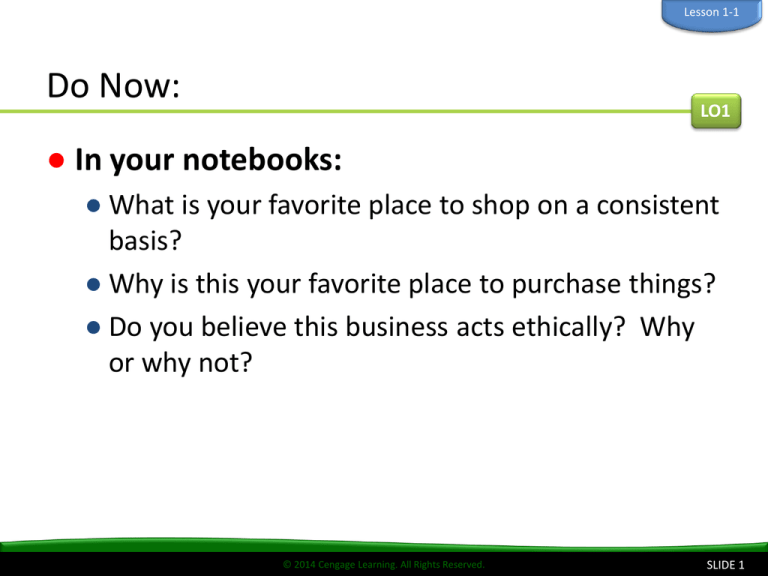
Lesson 1-1
Do Now:
LO1
● In your notebooks:
● What is your favorite place to shop on a consistent
basis?
● Why is this your favorite place to purchase things?
● Do you believe this business acts ethically? Why
or why not?
© 2014 Cengage Learning. All Rights Reserved.
SLIDE 1
Lesson 1-1
Turn & Talk:
LO1
● With a partner, agree on one of your two
businesses and answer the following question:
● What are different business activities that the
service business or retailer partakes in and data it
collects so that it can provide that good/service to
you?
© 2014 Cengage Learning. All Rights Reserved.
SLIDE 2
Our Centerpiece:
● MindTap!
● All working papers done here
● Some videos/articles attached
● PowerPoints accessible here
● http://www.cengage.com/us/
© 2014 Cengage Learning. All Rights Reserved.
SLIDE 3
Lesson 1-1
Closure:
LO1
● Exit Slip: What experiences have you had that
you feel relate to accounting?
● Hand your post-it note to me when finished
● HAVE A GREAT DAY!
© 2014 Cengage Learning. All Rights Reserved.
SLIDE 4
Lesson 1-1
Do Now:
LO1
● In your notebooks:
● Make a “KWL Chart” (Venn Diagram): What do
you know about accounting already (top left
circle) and what would you like to know (top right
circle, with bottom circle being left blank for
now)?
● One example may be…
● http://www.cengage.com/us/
© 2014 Cengage Learning. All Rights Reserved.
SLIDE 5
Lesson 1-1
The Role of Accounting
LO1
● Data must be recorded and reported in
accounting reports.
● Then, the information can be provided to
business owners, managers, investors, and others
to make business decisions and measure
performance.
● Accounting is called the language of business
because it has its own rules that must be learned
and practiced in order to operate a business
successfully
© 2014 Cengage Learning. All Rights Reserved.
SLIDE 6
Lesson 1-1
What Is Accounting?
LO1
● Accounting is the process of planning, recording,
analyzing, and interpreting financial information.
● Not just bookkeeping, but analyzing and interpreting
that data as well
● An accounting system is a planned process
designed to compile financial data and
summarize the results in accounting records and
reports.
● Financial reports that summarize the financial
condition and operations of a business are called
financial statements.
© 2014 Cengage Learning. All Rights Reserved.
SLIDE 7
Lesson 1-1
Accounting in Personal Life
LO2
● A net worth statement allows the person extending
the loan to see the financial position of a borrower
on a specific date and make a lending decision.
● Used for personal and business/professional situations
● Anything of value that is owned is called an asset.
● Jewelry, bike, cash, car
● An amount owed is called a liability.
● Owing money to friends, car loans, credit card bills
© 2014 Cengage Learning. All Rights Reserved.
SLIDE 8
Lesson 1-1
Accounting in Personal Life
LO2
● The difference between personal assets and
personal liabilities is called personal net worth.
● In business, net worth is also called equity.
● Equity is the difference between assets and
liabilities.
● Higher personal net worth if one owns more than
they owe
● Lender looks upon that person favorably because assets
are greater than liabilities
© 2014 Cengage Learning. All Rights Reserved.
SLIDE 9
Lesson 1-1
Personal Net Worth Statement
LO2
1
2
3
Total Assets
1 (owned)
−
Total Liabilities
2 (owed)
=
3 Net Worth
(also known as Equity)
© 2014 Cengage Learning. All Rights Reserved.
SLIDE 10
Think, Ink, Pair, Share:
● Imagine one of your siblings, guardians, or
friends ask to borrow a substantial amount of
money from you
● What things would you ask your siblings, parents,
cousins or friends before you so kindly agree to
lend them money
● When finished writing in your notebook, write a
few answers on the back board “Parking Lot”
© 2014 Cengage Learning. All Rights Reserved.
SLIDE 11
Your Turn
● Create your own personal net worth
statement in Excel using your current assets
and liabilities
● Be ready to share and discuss!
© 2014 Cengage Learning. All Rights Reserved.
SLIDE 12
Lesson 1-1
Ethics in Business
LO2
● The principles of right and wrong that guide
an individual in making decisions are called
ethics.
● The use of ethics in making business decisions
is called business ethics.
© 2014 Cengage Learning. All Rights Reserved.
SLIDE 13
Lesson 1-1
Lesson 1-1 Audit Your Understanding
1. What is accounting?
ANSWER
Accounting is the process of planning,
recording, analyzing, and interpreting
financial information.
© 2014 Cengage Learning. All Rights Reserved.
SLIDE 14
Lesson 1-1
Lesson 1-1 Audit Your Understanding
2. Why is accounting called the language of
business?
ANSWER
Accounting provides financial information
to everyone who needs it to make good
business decisions.
© 2014 Cengage Learning. All Rights Reserved.
SLIDE 15
Lesson 1-1
Lesson 1-1 Audit Your Understanding
3. Describe a scenario in which you, as a
nonaccountant, might use accounting.
ANSWER
Answers may include creating a personal
budget or providing information for a loan
or credit card application.
© 2014 Cengage Learning. All Rights Reserved.
SLIDE 16
Lesson 1-1
Think, Pair, Share
● Using MindTap, complete 1-1 WT with a
partner
● Then individually complete 1-1 OYO
● Be ready to review!
● If you have time, complete Application
Problem 1-1 in “Chapter 1 Review” section on
Mindtap…Homework if not completed!
© 2014 Cengage Learning. All Rights Reserved.
SLIDE 17
Lesson 1-1
Closure
● Finish your KWL chart using something you
have learned today that you did not previously
know or now know more about!
● Be ready to discuss!
© 2014 Cengage Learning. All Rights Reserved.
SLIDE 18




